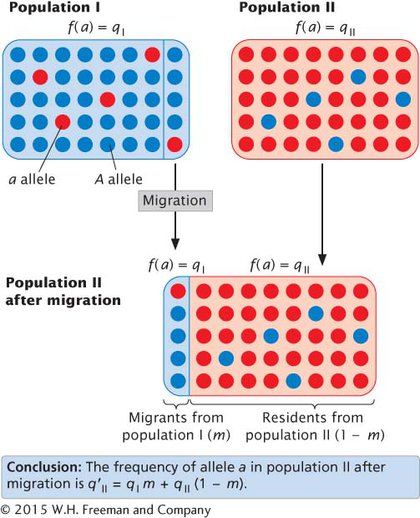Migration
Another process that may bring about change in a population’s allelic frequencies is the influx of genes from other populations, commonly called migration or gene flow. One of the assumptions of the Hardy–Weinberg law is that migration does not take place, but many natural populations do experience migration from other populations. The overall effect of migration is twofold: (1) it prevents populations from becoming genetically different from one another, and (2) it increases genetic variation within populations.
THE EFFECT OF MIGRATION ON ALLELIC FREQUENCIES Let’s consider the effects of migration by looking at a simple, unidirectional model of migration between two populations that differ in the frequency of an allele a (Figure 18.4). In each generation, a representative sample of the individuals in population I migrates to population II and reproduces, adding its alleles to population II’s gene pool. Migration is only from population I to population II (unidirectional), and all the conditions of the Hardy–Weinberg law (large population size, random mating, etc.) apply except the absence of migration.

After migration, population II consists of two types of individuals: (1) migrants with alleles from population I and (2) the original residents with alleles from population II. The allelic frequencies in population II after migration depend on the contributions of alleles from the migrants and from the original residents. The amount of change in the frequency of allele a in population II is directly proportional to the amount of migration; as the amount of migration increases, the change in allelic frequency increases. The magnitude of change is also affected by the difference in allelic frequencies between the two populations; when the difference is large, the change in allelic frequency will be large.
With each generation of migration, the allelic frequencies of the two populations become more and more similar until eventually, the frequencies of population II equal those of population I. When the allelic frequencies are equal, there will be no further change in the allelic frequencies of population II, in spite of the fact that migration continues. If migration between two populations takes place for a number of generations with no other evolutionary forces present, an equilibrium is reached at which the allelic frequencies of the recipient population equal those of the source population.
The simple model of unidirectional migration between two populations just outlined can be expanded to accommodate multidirectional migration between several populations.
THE OVERALL EFFECT OF MIGRATION Migration has two major effects. First, it causes the gene pools of separate populations to become more similar. Later in this section, we will see how genetic drift and natural selection lead to genetic differences between populations; migration counteracts this tendency and tends to keep populations homogeneous in their allelic frequencies. Second, migration adds genetic variation to populations. Different alleles may arise in different populations owing to rare mutational events, and these alleles can be spread to new populations by migration, increasing the genetic variation within the recipient population.
CONCEPTS
Migration causes changes in the allelic frequencies of a population by introducing alleles from other populations. The magnitude of change due to migration depends on both the amount of migration and the difference in allelic frequencies between the source and the recipient populations. Migration decreases genetic differences between populations and increases genetic variation within populations.
 CONCEPT CHECK 3
CONCEPT CHECK 3
Each generation, 10 random individuals migrate from population A to population B. What will happen to allelic frequency q as a result of migration when q is equal in populations A and B?
q in A will decrease.
q in B will increase.
q will not change in either A or B.
q in B will become q2.
c